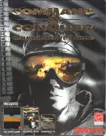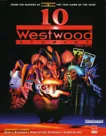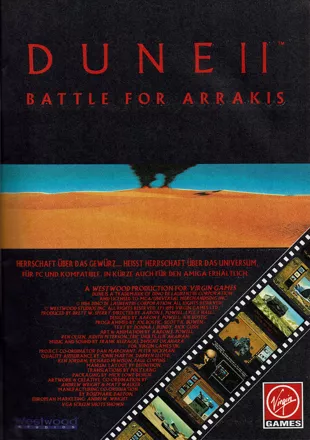Dune II: The Building of a Dynasty
Description official descriptions
The planet Arrakis (also known as Dune for its sandy landscape) is the only place in the known universe where Melange (more commonly known as the Spice) can be found. The Spice is the basis of interstellar travel and thus the standard of the Imperial economy. To increase productivity, The Padishah Emperor has invited three powerful Houses (Harkonnen, Atreides, and Ordos) to compete against one another economically and bring up spice production. Competition among these houses begins peacefully but soon turns ugly as they battle each other with armed troops, advanced weaponry, and spies. The planet itself is also hostile, with dangerous sandworms inhabiting the spice fields.
Dune II is often considered the first mainstream modern real-time strategy game and established many conventions of the genre. Even though set in Frank Herbert's famous Dune universe, the game is only loosely connected to the plot of any of the books or the films based on them. Controlling either of the three Houses, the player must fight a number of battles against the other Houses. In the early levels, the goal is simply to earn a certain number of credits, while in the later missions, all enemies must be destroyed.
The single resource in the game is the Spice, which must be collected by harvesters. The spice is converted to credits in a refinery, which are then spent to construct additional buildings and units. There are two terrain types: buildings can only be constructed on stone, while the Spice is only found on the sand. However, units moving on sand attract the large sandworms of Dune, who are virtually indestructible and can swallow even large units whole. As levels progress, new and more advanced buildings and units are made available, including structures like a radar station, a repair facility, or defense turrets and, for units, various ground troops, light vehicles, and tanks. Each House can construct one unique special unit, and, after building a palace improvement, can unleash a unique palace effect.
After a mission is completed, the player can select the next mission on a map of Dune. This choice determines the layout of the next map to be played but has no effect on the overall campaign.
Spellings
- Dune II: Битва Древних Династий - Russian spelling
- הקרב על אראקיס :II חולית - Hebrew spelling
- 沙丘魔堡II :王朝的建立 - Traditional Chinese spelling
Groups +
Screenshots
Promos
Credits (DOS version)
47 People (44 developers, 3 thanks) · View all
| Design | |
| Programming | |
| Graphics / Artwork | |
| Musical Lead and Soud Effect Verification | |
| Music | |
| Sound | |
| Cover Art | |
| Documentation | |
| Producer | |
| Director | |
| Project Coordination in UK | |
| Writing / Dialogue / Story | |
| Quality Assurance | |
| [ full credits ] | |
Reviews
Critics
Average score: 86% (based on 33 ratings)
Players
Average score: 3.9 out of 5 (based on 177 ratings with 16 reviews)
The Good
This game practically invented the genre, which is kind of odd considering the ridiculously pathetic games that followed it from the same company (C&C etc.)
The graphics are (for the time) really good, the gameplay is the most addictive I've ever experienced, the music is simply wonderful and the general atmosphere of the game is great.
The Bad
I guess I can't hold it against the game (since it was one of the first), but controlling the units can be extremely annoying at times, especially because you can't control more than one at a time.
The Bottom Line
The game can still be acquired in shops for a ridiculous price -- get it! You won't regret you did.
DOS · by Tomer Gabel (4539) · 1999
The first game of the real-time strategy genre, and a good one too.
The Good
Many things.. the graphics were/are pretty nice,
the aurality is fine (Musics are dynamic and good)
and the game style was new when Dune2 arrived.
And the intro is terrific. :) And the Mentat is great.
The Bad
Hum.. some tidbits.
Controlling the troops is a bit irritating with the bad control system, some of the internal balance is screwed (Just try to use something less than an entire army to destroy a building that is being repaired)
and the plot is pretty weak, and doesn't quite have much
to do with any of the actual Dune books.
The Bottom Line
The game that started the modern bad RTS genre,
definitely worth a look. Forget Dune2000.
DOS · by RmM (68) · 1999
The Good
This game was a great competitor for the original Warcraft, and surpassed that game in many respects. It has great graphics, 3 campaigns, tons of units, hours upon hours of good gameplay. Several units could only be obtained by one faction.
The Bad
The only thing I didn't like about this game was that all the units, save the ones that were only for one faction, looked the same except for color.
The Bottom Line
Great RTS game for newbies to the genre. Good MCGA graphics, good mouse support. Definitely buy if you can get it for a reasonable price
DOS · by Ben Jacobs (10) · 2000
Discussion
| Subject | By | Date |
|---|---|---|
| Old third-party extras for Dune II (PC) | MrFlibble (18056) | Aug 29th, 2012 |
Trivia
1001 Video Games
Dune II appears in the book 1001 Video Games You Must Play Before You Die by General Editor Tony Mott.
AI
The computer cheats. The AI does not get unlimited money per se, and its economy can be drained. However there are several situations where the AI gets a money boost: first off, a little amount of credits is added whenever it gets a replacement harvester (this is also true for the player). Secondly, whenever an AI player's structure is destroyed, it seems to get some money back. It can build units without refineries.
Credits
A largely unknown but very curious feature in Dune II is that a small amount of credits is frequently subtracted from the player's budget, the amount directly proportional to the current power consumption in the player's base. In other words, the players pay for the power they use.
While many people have observed seemingly random "leaks" of credits while playing the game, the real reason was found by TrueBrain of OpenDUNE team. The full account can be found here.
Development
Westwood artist/designer Joseph Hewitt:
Dune II has long held the honor of being the first real-time strategy game. There has been some dispute to this claim with people pointing out some of Westwood's earlier titles such as BattleTech: The Crescent Hawks' Revenge and the previous title BattleTech: The Crescent Hawk's Inception. Other games like The Ancient Art of War have come up as even pre-dating those. I could also mention most of SSI's catalog of strategy games, some of which Westwood ported to the Amiga and Atari ST in their early days. The point is, those are turn-based strategy games (TBS) where you take turns moving units with your opponent(s). Dune II was an evolutionary step forward with "real-time" action. There were no longer any turns, everything happened in real time. Comparing turn-based strategy to real-time strategy is like comparing chess to hockey. Nothing wrong with either, but the pace and strategic thinking used in the two is quite different. This jump in evolution was so different from previous strategy games that phrases" turn-base" and "real-time" came in to being to separate them.
It would be unfair to not give credit where credit is due however. One of the things our industry has done from the beginning is building on the success of previous games. Taking what has come before, polishing it, adding something new and creating something new out of it. Dune II was no exception and was inspired by some other great games. A lot of the development and production side of the game was inspired by Populous and Sid Meier's Civilization, two games that were played quite a bit in the office. But the most credit should go to a little known Sega Genesis game we were playing in the office called, Herzog Zwei. Herzog Zwei can be viewed as a real-time game, but it isn't generally lauded as the first RTS because it isn't really the same type of game. Herzog Zwei was its own unique thing and feels more arcadey than a strategy game. The player isn't individually controlling all the units in Herzog Zwei, so much as controlling one unit that is kind of a transport director. Dune II, on the other hand, took all the elements of a traditional turn-based strategy game, large armies of units, added resource collection and base building, and had you manage them in real-time. This was quite different than the turn-based strategy games that it was born out of.
Editor
Dune II utilizes "PAK"-files, which are essentially several files archived in one. It is extremely easy to figure out the format and write a packer/unpacker. Therefore, an unofficial Dune II level editor was written as a third-party freeware program by an unknown fan in 1996. it can be downloaded from the Dune II: the Building of an Empire website.
Mentats
You can make a mentat blink or move its mouth by clicking on his eyes or lips, respectively. The same is true with the girl telling you about the houses at the beginning of the game.
Ordos
Out of the three playable Houses in Dune II, House Ordos is never mentioned in Franks Herbert's books. The development team borrowed the name and the herald of the Ordos from The Dune Encyclopedia, a third-party compilation of Dune related material that was approved by Frank Herbert.
Here's an account of this by Marc Cram:
I was a producer and designer for this project. The original idea was to make a game that captured the fun and imagination of those plastic army men. There were a couple of games out of Germany that were heading in that direction, but nothing that had all of the different equipment and abilities that we wanted to put into a game.
Virgin had the license to do Dune. They secretly gave to the project both to Westwood and a French company (cannot remember the name.) The French finished the game first, which was a 3D crawl game.
Our thoughts were that the story was too complex and rich to replicate in a video game. We decided that it would be best to take all of the fun elements in the game and create our own story.
I had read the books once and was a little confused as to all of the elements, but my friend Wesley (by the way, Wes is in another game. Eye of the Beholder I & II. The character's name is Wently Kelso and he is an apathetic archeologist, which fits the real Wesley's personality perfectly.) Anyway, Wesley was a big fan of the books and so I invited him to lunch at the Golden Nugget buffet.
Over a piece of salty roast beef, he pulls out the Dune Encyclopedia. He told me that the book was very rare and would not let me take it home. So on the back of a Keno pad I started writing down the profiles of all of the houses. (I think I still have the Keno pad).
Originally, I was going to use House X as one of the houses, but it seemed better as a resource. Also, living in Vegas, the House Ordos seemed like the Mafia. This appealed to me for some reason.
Like many other non-canonical Houses introduced in the Dune Encyclopedia, House Ordos bears the name of a real geographical location, suggesting it originates from Old Terra. House Ordos is only briefly mentioned in the Encyclopedia, so its background in the games was entirely created by the development team. While the Atreides and Harkonnen heralds in Dune II were taken from the Encyclopedia, the Ordos herald with the snake and the book was taken from another House, Wallach. Dune Encyclopedia describes the Ordos herald as crossed bones with a green ivy on golden background.
Patch
The patched game (v. 1.07) is incompatible with old saves, but a very nice feature is included: If you try loading an old save, the game will recognise which mission you were on and will simply restart it, meaning not all of your progress will be lost.
Super Dune 2
An unofficial add-on called Super Dune 2 was released by some hackers around 1994. This add-on changed the three original Houses to the previously unplayable Fremen, Sardaukar and the unused Mercenaries faction (which was apparently planned by the developers to own the Saboteur Ordos superweapon, but that was dropped in the PC and Amiga versions). The add-on featured more challenging missions, however, the game mechanics remained largely unaffected. Thus, the "new" factions all have similar tech trees (with all units but the Ordos Deviator and Ordos Raider Traike available), and the only difference is in Palace superweapons: the Fremen have Fremen reinforcements (Atreides weapon), the Sardaukar have the cluster missile (Harkonnen weapon), and the Mercenaries have the Ordos Saboteur. Also, Fremen have control over some of the sandworms on the maps.
The add-on also had a few bugs stemming from the fact that the "new" factions were never meant to be playable. The most noticeable is that the Mercenary and Sardaukar players are unable to properly lay out concrete blocks, which they can only placed adjacent to other structures, but not to other concrete blocks or walls. This limited base construction and layout, and also forced the player to spend credits on repairs of structures placed on incomplete concrete foundations.
Other bugs were of a more cosmetic nature. Territories conquered by Fremen and Mercenaries would become discoloured on the conquest map; the Mentat facial animations of Fremen and Sardaukar were all messed up because the proper coordinates for eye and mouth frames were never set in the game executable. The Mercenary Mentat would often appear with the wrong palette, as it uses a separate palette for the House introduction screen in the original game. Also, all new factions would get the Atreides victory cinematic when the game was completed.
Awards
- Amiga Joker
- Issue 02/1994 – #3 Best Strategical in 1993 (Readers' Vote)
- Computer Gaming World
- October 1993 (Issue #111) – Strategy Game of the Year
- November 1996 (15th anniversary issue) - #70 in the “150 Best Games of All Time” list
- GameStar (Germany)
- Issue 12/1999 - #30 in the "100 Most Important PC Games of the Nineties" ranking
Information also contributed by Chentzilla, Henry Aloni, hydra9, Indra was here, Joseph Hewitt, Lev Epshteyn, Maw, MrFibble, PCGamer77 and Qlberts
Analytics
Related Sites +
-
Dune 2: The building of an empire
A fan page devoted to the game Dune II. -
Dune II: The Building of a Dynasty Home Page
official game page at Westwood Studios' website from 1997, preserved by the Wayback Machine -
Extended Reference
Handy resource, with detailed information, tables, and more.
Identifiers +
Contribute
Are you familiar with this game? Help document and preserve this entry in video game history! If your contribution is approved, you will earn points and be credited as a contributor.
Contributors to this Entry
Game added by Tomer Gabel.
Amiga added by Famine3h. Acorn 32-bit added by Kabushi.
Additional contributors: xroox, PCGamer77, Ledmeister, Игги Друге, DarkDante, Crawly, Strangerhand, Paulus18950, Patrick Bregger, Nightson Blaze, Jiseng So, MrFlibble, FatherJack, Bart Smith.
Game added August 22nd, 1999. Last modified January 23rd, 2024.























